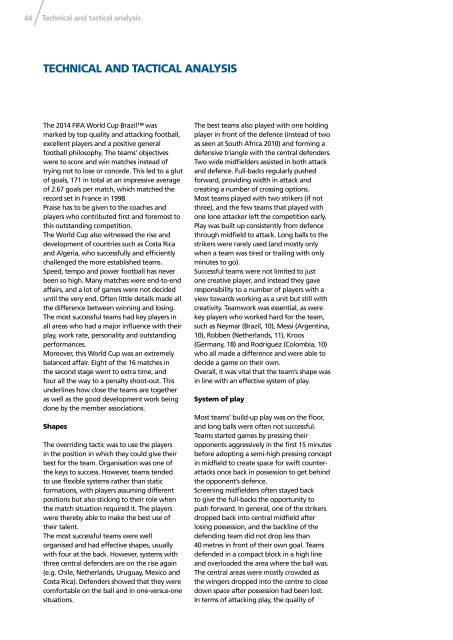You also want an ePaper? Increase the reach of your titles
YUMPU automatically turns print PDFs into web optimized ePapers that Google loves.
44Technical and tactical analysisTECHNICAL AND TACTICAL ANALYSISThe 2014 FIFA World Cup Brazil wasmarked by top quality and attacking football,excellent players and a positive generalfootball philosophy. The teams’ objectiveswere to score and win matches instead oftrying not to lose or concede. This led to a glutof goals, 171 in total at an impressive averageof 2.67 goals per match, which matched therecord set in France in 1998.Praise has to be given to the coaches andplayers who contributed first and foremost tothis outstanding competition.The World Cup also witnessed the rise anddevelopment of countries such as Costa Ricaand Algeria, who successfully and efficientlychallenged the more established teams.Speed, tempo and power football has neverbeen so high. Many matches were end-to-endaffairs, and a lot of games were not decideduntil the very end. Often little details made allthe difference between winning and losing.The most successful teams had key players inall areas who had a major influence with theirplay, work rate, personality and outstandingperformances.Moreover, this World Cup was an extremelybalanced affair. Eight of the 16 matches inthe second stage went to extra time, andfour all the way to a penalty shoot-out. Thisunderlines how close the teams are togetheras well as the good development work beingdone by the member associations.ShapesThe overriding tactic was to use the playersin the position in which they could give theirbest for the team. Organisation was one ofthe keys to success. However, teams tendedto use flexible systems rather than staticformations, with players assuming differentpositions but also sticking to their role whenthe match situation required it. The playerswere thereby able to make the best use oftheir talent.The most successful teams were wellorganised and had effective shapes, usuallywith four at the back. However, systems withthree central defenders are on the rise again(e.g. Chile, Netherlands, Uruguay, Mexico andCosta Rica). Defenders showed that they werecomfortable on the ball and in one-versus-onesituations.The best teams also played with one holdingplayer in front of the defence (instead of twoas seen at South Africa 2010) and forming adefensive triangle with the central defenders.Two wide midfielders assisted in both attackand defence. Full-backs regularly pushedforward, providing width in attack andcreating a number of crossing options.Most teams played with two strikers (if notthree), and the few teams that played withone lone attacker left the competition early.Play was built up consistently from defencethrough midfield to attack. Long balls to thestrikers were rarely used (and mostly onlywhen a team was tired or trailing with onlyminutes to go).Successful teams were not limited to justone creative player, and instead they gaveresponsibility to a number of players with aview towards working as a unit but still withcreativity. Teamwork was essential, as werekey players who worked hard for the team,such as Neymar (Brazil, 10), Messi (Argentina,10), Robben (Netherlands, 11), Kroos(Germany, 18) and Rodríguez (Colombia, 10)who all made a difference and were able todecide a game on their own.Overall, it was vital that the team’s shape wasin line with an effective system of play.System of playMost teams’ build-up play was on the floor,and long balls were often not successful.Teams started games by pressing theiropponents aggressively in the first 15 minutesbefore adopting a semi-high pressing conceptin midfield to create space for swift counterattacksonce back in possession to get behindthe opponent’s defence.Screening midfielders often stayed backto give the full-backs the opportunity topush forward. In general, one of the strikersdropped back into central midfield afterlosing possession, and the backline of thedefending team did not drop less than40 metres in front of their own goal. Teamsdefended in a compact block in a high lineand overloaded the area where the ball was.The central areas were mostly crowded asthe wingers dropped into the centre to closedown space after possession had been lost.In terms of attacking play, the quality of


